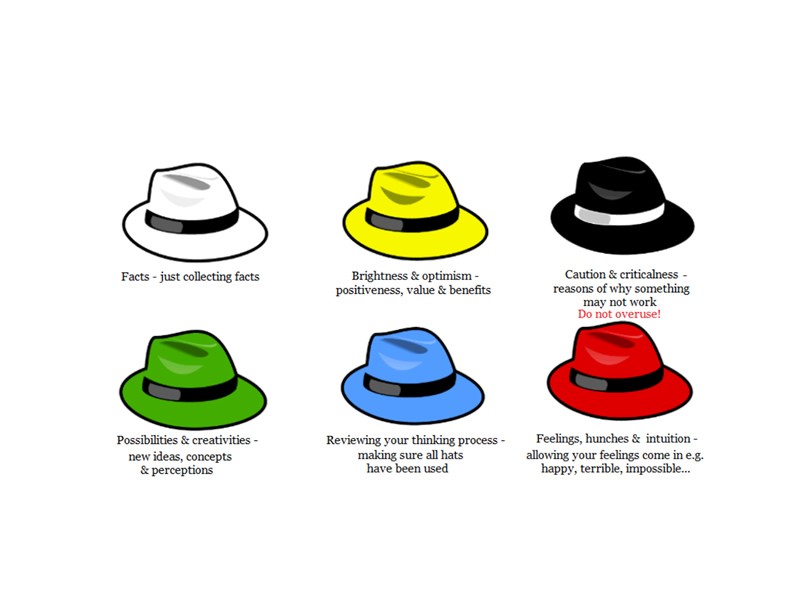Insight Blog
Agility’s perspectives on transforming the employee's experience throughout remote transformation using connected enterprise tools.
18 minutes reading time
(3672 words)
Debono Thinking Hats & Its Importance In The Advancement of AI
Explore how Debono Thinking Hats enhance AI development with structured decision-making and innovative problem-solving strategies.
Debono Thinking Hats, a method devised by Edward de Bono, introduces a structured way for teams to think collectively while addressing complex issues. This approach segments thinking into six distinct categories—each represented by a colored hat—to streamline and enhance decision-making processes.
In the field of artificial intelligence (AI), this method is particularly relevant as it fosters a comprehensive exploration of ideas, risks, benefits, creativity, and management of information, which are critical when developing and implementing AI technologies.
The application of the Six Thinking Hats can lead to more innovative AI solutions and more effective problem-solving, highlighting its significant potential impact on the advancement of AI.
What is Debono Thinking Hats?
Ok, so the quesion is, What is Debono Thinking Hats?
De Bono's Six Thinking Hats method offers a versatile approach to examining decision-making processes from different perspectives. This powerful technique encompasses six distinct modes of thinking, each represented by a unique colored hat.
Whether used individually or collaboratively within a team, this method empowers you to adapt your thinking to different situations and challenges.
Six thinking hats example scenarios pdf
Students discover six distinct modes of thinking, symbolized by various colored hats, which they can employ in any scenario.
Here are six example scenarios utilizing the six thinking hats approach in a PDF.
A Brief Primer on Debono Thinking Hats
Origin of Six Thinking Hats
Dr. Edward de Bono, a leading advocate for creative thinking and lateral problem-solving, pioneered the concept of the six thinking hats. Through his extensive work in innovation and cognitive psychology, Dr. de Bono crafted a structured method to liberate individuals from conventional thinking patterns and empower them to produce inventive solutions.
In his seminal work "Six Thinking Hats," published in 1985, Dr. de Bono introduced this groundbreaking approach to the world, sparking widespread interest in its application across diverse fields. Since then, organizations, educators, and individuals have embraced the six thinking hats methodology to enhance their thinking processes and unleash higher levels of productivity and creativity.
What are Debono Thinking Hats?
Debono Thinking Hats offer a unique and structured approach to thinking and decision-making, developed by Edward de Bono. This method employs six colored hats, each representing a different perspective on a problem, facilitating a more organized way to explore challenges and develop solutions.
- Blue Hat: The Blue Hat facilitates organization and strategic planning, encourages structured thinking, and establishes clear objectives.
- Green Hat: Embracing innovative and creative thought processes, the Green Hat fosters brainstorming and exploring unconventional ideas to inspire inventive solutions.
- Red Hat: Acknowledging emotions and instincts, the Red Hat encourages intuitive responses and the consideration of gut feelings in decision-making processes.
- Yellow Hat: Focusing on benefits and values, Yellow Hat promotes optimism and identifying positive outcomes, emphasizing the importance of constructive thinking.
- Black Hat: By conducting risk assessments and critical analysis, Black Hat encourages cautious evaluation and the identification of potential pitfalls or drawbacks in proposed strategies.
- White Hat: Emphasizing the gathering of factual information and data analysis, the White Hat supports objective reasoning and the exploration of relevant insights to inform decision-making
By directing thinking according to the color of the hat worn, participants can switch perspectives easily, ensuring a more comprehensive examination of issues which leads to better decision-making outcomes in both group and individual settings.
Concept and Origin of the Six Thinking Hats Method
The Six Thinking Hats method was conceived by Edward de Bono in the 1980s as a revolutionary approach to thinking and group work. Inspired by the brain's complex processes, de Bono designed the method to simplify and coordinate thinking by dividing it into six clear functions, each represented by a different colored hat.
This method encourages deliberate thinking that is suited to each function, providing a means to consciously and effectively analyze issues and generate ideas, thereby enhancing both individual and collaborative problem-solving efforts.
Six Hats and What They Represent
The Six Thinking Hats each serve a distinct purpose in the thinking process: the White Hat calls for focusing on the data available; the Red Hat encourages the expression of emotions and feelings; the Black Hat looks at the possible pitfalls and the worst-case scenarios; the Yellow Hat helps identify the value and benefits; the Green Hat fosters creativity and the generation of new ideas; and the Blue Hat manages the overall thinking process, ensuring that each hat's perspective is adequately explored.
This method not only streamlines the thinking process but also facilitates deeper understanding and clearer communication within teams, making complex decision-making more efficient and effective.
How to Get Started with Six Thinking Hats
To embrace the six thinking hats methodology, start by understanding the distinct roles of each hat. Here are actionable steps for implementing this structured thinking approach:
- Familiarize Yourself with Each Hat: Learn about the principles and characteristics of the blue, white, red, black, yellow, and green hats. Understand how each contributes uniquely to the thinking process.
- Identify a Relevant Scenario: Choose a specific problem, decision, or concept that requires thorough analysis and decision-making.
- Assign Hat Roles: In a group setting, assign hat roles to team members. Ensure each mode of thinking is represented effectively.
- Sequential Hat Application: Encourage participants to wear each hat in sequence. Focus solely on the perspective associated with the assigned hat before moving to the next.
- Facilitate Constructive Discussions: Promote open and collaborative discussions. Allow individuals to express their thoughts within the context of their assigned hat. This fosters diverse insights and perspectives.
By following these steps, you can effectively integrate the six thinking hats approach into your decision-making processes. Utilize its structured framework to conduct comprehensive analyses and make well-informed decisions.
The Six Thinking Hats Method & Its Importance in AI
Enhancing Decision-Making Processes in AI Development
The Six Thinking Hats method significantly enhances decision-making processes in AI development by structuring thought processes in a way that covers all bases, from factual data gathering to exploring creative solutions. In AI development, where decisions can have far-reaching implications, applying this method ensures a thorough analysis and assessment.
For example, the White Hat's focus on available data helps in grounding AI algorithms in reliable, current datasets, crucial for training accurate models. The Black Hat's critical viewpoint helps identify potential risks in deploying AI systems, such as ethical concerns or biases, which might be overlooked in a more unidirectional approach.
Simultaneously, the Blue Hat manages the process, ensuring that AI development efforts remain focused and aligned with the project's goals, thereby streamlining development and reducing time to market.
Promoting Innovative Thinking and Problem-Solving in AI Projects
When it comes to AI, where innovation is key to staying ahead of technological curves, the Six Thinking Hats method plays a crucial role in promoting innovative thinking and effective problem-solving.
By segmenting thinking into distinct modes, AI teams can unleash creative potential (Green Hat) without the constraints of practicality or judgment. This is particularly valuable in brainstorming sessions for new features in AI applications or troubleshooting AI systems. The Red Hat allows team members to express intuitive judgments and emotional responses, providing a perspective that is often underappreciated in the highly technical AI field but crucial for user-centric design.
The comprehensive exploration of ideas and challenges through these varied lenses not only leads to more creative solutions but also ensures that innovations are robust and comprehensively evaluated before implementation, thereby increasing the success rate of AI projects.
6 Thinking Hats Examples
Discover the power of Six Thinking Hats with practical examples that showcase its effectiveness in decision-making and problem-solving. This innovative methodology allows individuals and teams to navigate complex challenges with clarity and creativity. Explore real-world scenarios illustrating the application of Six Thinking Hats to enhance collaboration, challenge assumptions, and generate innovative solutions. Unleash the potential of Six Thinking Hats examples to transform your approach to decision-making and drive success in any endeavor.
Application of the Six Thinking Hats in AI-Related Scenarios
6 Thinking Hat examples can be given from AI-related scenarios, where they provide a structured framework to dissect complex problems systematically.
By assigning specific modes of thinking to different stages or aspects of a problem, AI teams can ensure that all potential angles are considered. For instance, when developing an AI for healthcare diagnostics, the White Hat's focus on objective information guides the team in gathering accurate medical data and previous case studies.
This ensures that the AI system is built on a solid foundation of verifiable information. Following this, the Red Hat allows the team to reflect on their instinctive feelings about the potential implications of the AI in real-world medical scenarios, ensuring that ethical considerations and patient care remain at the forefront of development.
This comprehensive approach helps in addressing not only the technical capabilities of AI systems but also their practical and ethical applications, making the technology more robust and reliable.
Case Study: Enhancing Algorithm Accuracy
In a case study focusing on enhancing algorithm accuracy, the use of the Six Thinking Hats method can lead to significant improvements.
Initially, under the White Hat, the team compiles and analyzes user feedback data to identify common issues with an AI-driven recommendation engine. Moving to the Black Hat, the team then critically examines the current algorithm for potential flaws or biases that may cause these issues, fostering a cautious approach to troubleshoot problems before they affect more users.
Next, the Green Hat inspires the team to explore innovative solutions, such as incorporating machine learning models that adapt more dynamically to user behavior patterns. The resultant adjustments to the algorithm not only improve its accuracy but also enhance user satisfaction by delivering more personalized and relevant recommendations.
This process exemplifies how the Six Thinking Hats method facilitates a disciplined yet creative approach to solving complex technical challenges in AI development.
Scenario: AI for Predictive Maintenance
In another scenario, an AI team applies the Six Thinking Hats method to develop a predictive maintenance system for industrial equipment.
Starting with the Yellow Hat, the team focuses on the potential benefits of the system, such as cost savings and increased efficiency. This optimistic perspective motivates the team to pursue ambitious goals in AI performance. Transitioning to Red Hat, the team considers their gut feelings about which features will be most valuable for end-users, integrating human-centric considerations into the system's design.
Finally, under the guidance of the Blue Hat, the team reviews all the insights gathered through the different hats and constructs a comprehensive plan that combines technical feasibility with practical utility.
This plan leads to the development of an AI system that not only predicts equipment failures before they occur but also integrates seamlessly with existing workflows, demonstrating how diverse perspectives can combine to produce a well-rounded and effective AI solution.
How To Use The 6 Hats Technique?
Step-by-Step Guide for Implementation
6 Hats Technique can be implemented in AI research and development. It can be started by educating the team on the purpose of each colored hat and the rules for their use.
Begin with the White Hat to objectively gather all relevant data and information. Shift to the Red Hat to express emotions and gut reactions without justification, followed by the Black Hat to critically assess potential risks and downsides. Utilize the Yellow Hat to explore the positives and potential benefits. Encourage creative and lateral thinking with the Green Hat, generating new ideas and alternative solutions.
So, apply the Blue Hat to oversee and orchestrate the process, summarizing insights and formulating a coherent path forward. This methodical approach ensures that all aspects of the project are considered from multiple perspectives, enhancing decision-making and problem-solving.
Follow us and access great exclusive content everyday: Follow us on Google News
Best Practices and Tips
For teams using the 6 Hats Technique in AI development or individual problem-solving, several best practices enhance its effectiveness.
First, clearly define and limit the time spent under each hat to keep discussions productive and on point. Encourage all team members to contribute in each phase, which promotes diverse perspectives and richer solutions. Utilize physical props like colored hats or cards to help participants fully engage with the specific thinking mode required. Regularly switch hats to adapt to new insights or changes in the project's scope, ensuring flexibility and responsiveness to evolving challenges.
By fostering an environment where each viewpoint is systematically explored, the 6 Hats Technique not only broadens the scope of ideas and solutions but also strengthens team collaboration and alignment.
What are some six thinking hats example questions
- White Hat (Facts and Information):
- What are the current statistics on our project's progress?
- What data supports this decision?
- What are the key facts we need to consider before moving forward?
- Red Hat (Emotions and Intuition):
- How do you feel about the proposed changes?
- What's your gut reaction to this idea?
- Do you sense any potential risks that aren't immediately apparent?
- Black Hat (Critical Thinking and Caution):
- What are the potential drawbacks of this strategy?
- What are the weaknesses in our current plan?
- What are the reasons why this might not work?
- Yellow Hat (Optimism and Positivity):
- What are the benefits of implementing this solution?
- What positive outcomes can we expect from this decision?
- How might this approach improve our situation?
- Green Hat (Creativity and Innovation):
- How can we approach this problem from an entirely new angle?
- What are some unconventional ideas we still need to consider?
- How might we leverage emerging technologies to enhance our solution?
- Blue Hat (Meta-Cognition and Organization):
- What's our main objective here, and how does this decision align with it?
- What's the next step in our decision-making process?
- How can we ensure that everyone's perspectives are heard and considered?
These questions can help guide discussions and decision-making processes using the Six Thinking Hats method, which encourages participants to explore different perspectives and modes of thinking.
More Six Thinking Hats Exercise
The Six Thinking Hats methodology serves as a versatile tool for decision-making, idea generation, assumption scrutiny, and facilitating dialogue. Widely embraced by individuals, leaders, and teams globally across various sectors, including business and government, it fosters structured thinking and collaborative problem-solving.
Here are More Six Thinking Hats Exercise:
You may also like: Best Apps for Employees: UPDATED 2022 – A Complete Guide
Role-Switching Exercise
One effective variation of the Six Thinking Hats exercises involves role-switching to deepen understanding and empathy across different perspectives.
In this exercise, team members switch hats midway through the session, allowing them to adopt and argue from perspectives they initially did not hold. For example, a team member who starts with the Black Hat, focusing on potential risks, will switch to the Yellow Hat to explore the positives.
This exercise encourages team members to step outside their usual thought patterns and consider alternative viewpoints, which can lead to more comprehensive evaluations and innovative solutions in AI development.
Scenario Analysis Drill
Another practical exercise is the scenario analysis drill, where teams use the Six Thinking Hats to explore potential future scenarios in AI projects.
Each hat is used to analyze a specific future scenario, such as the successful implementation of an AI system or facing significant technical setbacks. For instance, using the Green Hat, teams brainstorm creative solutions to overcome hypothetical obstacles, while the Red Hat might be used to discuss team members' gut feelings about the scenario's impact.
This exercise helps teams prepare for various possibilities, ensuring that AI projects are robust against potential future challenges and can adapt to changing circumstances.
Reverse Thinking Session
The reverse thinking session encourages teams to approach problems from a completely opposite perspective than usual.
For instance, if the team typically focuses on why an AI project might succeed (Yellow Hat), they are tasked with thinking about why it might fail (Black Hat). This exercise helps to uncover hidden risks or overlooked weaknesses and fosters a more thorough analysis of AI development projects.
It can be particularly useful in identifying non-obvious challenges that could derail a project, enabling the team to develop strategies to mitigate these risks early on.
Six thinking hats advantages and disadvantages
6 thinking hats advantages
- Structured Thinking: It provides a structured framework for approaching problems, ensuring that all aspects are considered systematically.
- Parallel Thinking: It encourages participants to think in parallel rather than engaging in confrontational or competitive thinking, fostering collaboration and creativity.
- Focus on Different Perspectives: Each hat represents a different perspective (e.g., logical, emotional, creative), allowing participants to consider a problem from multiple viewpoints.
- Enhanced Communication: By assigning roles to different hats, it facilitates clearer communication and reduces misunderstandings among team members.
- Improved Decision Making: The method helps in making more balanced and informed decisions by considering various factors and viewpoints.
- Time Efficiency: By providing a structured process, it can lead to more efficient meetings and discussions, as it guides participants through different aspects of the problem or d
6 thinking hats disadvantages
- Over-simplification: The method may oversimplify complex issues by categorizing them into six distinct perspectives, potentially overlooking nuances and intricacies.
- Rigid Structure: The structured nature of the method may hinder flexibility and adaptability, as it requires participants to follow a predefined process.
- Limited Creativity: While the method aims to foster creativity, some individuals may feel constrained by the predefined roles of each hat, limiting their ability to think outside the box.
- Complexity: Learning and implementing the Six Thinking Hats method requires time and effort, which may be challenging for teams already dealing with tight schedules or unfamiliar with the approach.
- Dependence on Facilitator: The effectiveness of the method often relies on a skilled facilitator to guide the process and ensure all perspectives are adequately explored. Without proper facilitation, the method may not yield optimal results.
- Potential for Bias: Despite its intention to promote balanced thinking, the method may still be susceptible to individual biases, as participants may unconsciously favor certain perspectives or hats over others.
Enhancing Decision-Making Through the Six Thinking Hats Technique
Edward de Bono likened confronting complex decisions to juggling excessive balls simultaneously. Many individuals find themselves overwhelmed by a whirlwind of emotions, facts, and ideas intertwined, leading to mental fatigue. Compared to a juggler burdened with too many objects, maintaining focus becomes challenging, resulting in dropped balls rather than resolving matters before commencement.
The Six Hats technique functions like training wheels for the mind. Instead of attempting to manage everything simultaneously, it deconstructs thought processes into distinct stages. Donning one hat at a time enables concentration on individual perspectives, thus averting stress induced by information overload.
The Six Thinking Hats technique, a unique strategic thinking approach, offers a multitude of benefits:
- Embracing diverse perspectives: Each hat facilitates diverging from habitual problem viewpoints, fostering a comprehensive comprehension of varying outlooks and, consequently, more holistic decisions.
- Cultivating creativity: Employing diverse hats stimulates the exploration of novel ideas and prevents adherence to conventional thought patterns, thus igniting innovative perspectives typically absent in routine discussions.
- Improving communication skills: Each hat aids in articulate expression, facilitates idea exchange and comprehension, and enhances interpersonal dynamics and team cohesion.
- Mitigating conflicts: Differing roles mitigate misunderstandings from distinct thinking styles, fostering a harmonious environment conducive to streamlined decision-making.
- The Six Hats technique provides a practical and effective solution by breaking down complex decisions into manageable steps. It reduces team overwhelm and guides a clear path forward. Enhancing meeting efficiency:
- The Six Hats method streamlines meetings by furnishing a structured framework and curtailing tangential discussions, thereby maintaining focus and advancing collective objectives.
The Six Thinking Hats technique is a versatile tool that can significantly enhance decision-making in businesses of all sizes. Whether you're a solopreneur or part of a large team, this approach can be customized to meet your specific needs, making it a powerful tool for problem-solving and fostering creativity.
Real-world Implementations of the Six Thinking Hats Technique
The Six Thinking Hats method can be applied to various decision-making scenarios across multiple domains.
- Product Development: Teams can utilize the Six Thinking Hats to comprehensively assess new products, considering customer preferences, potential challenges, and innovative approaches.
- Project Management: Employing this method aids in effective project management by structuring plans, acknowledging team dynamics, and anticipating unforeseen circumstances.
- Marketing Strategy: The Six Hats technique proves invaluable in crafting marketing strategies that blend empirical data with an understanding of customer sentiments, fostering the generation of novel and appealing concepts.
- Customer Experience: Enhancing the customer experience entails employing the Six Thinking Hats to empathize with customers, anticipate their needs, and rectify any issues.
- Conflict Resolution: Resolving conflicts is facilitated by systematically exploring all perspectives, encompassing emotional considerations and logical reasoning to devise mutually beneficial solutions.
- Long-Term Planning: When it comes to long-term strategic planning, the Six Hats offer a multifaceted approach. They enable teams to envision future trends and challenges while maintaining a balance of optimism, caution, and innovative thinking.
Free ebook: How To Get Your Intranet Off The Ground
Wrapping up
The Debono Thinking Hats method offers a dynamic and structured approach to exploring complex problems, particularly in the field of AI development.
By adopting different perspectives systematically, teams can uncover innovative solutions, anticipate potential challenges, and enhance decision-making processes. Utilizing exercises such as role-switching, scenario analysis, and reverse thinking can deepen engagement with each perspective and broaden the scope of analysis.
Implementing these techniques ensures that AI projects are not only innovative but also robust and responsive to changes, ultimately leading to more successful outcomes and advancing the field of artificial intelligence.
Categories
Blog
(2636)
Business Management
(325)
Employee Engagement
(212)
Digital Transformation
(176)
Growth
(120)
Intranets
(119)
Remote Work
(61)
Sales
(48)
Collaboration
(36)
Culture
(29)
Project management
(29)
Customer Experience
(26)
Knowledge Management
(21)
Leadership
(20)
Comparisons
(6)
News
(1)
Ready to learn more? 👍
One platform to optimize, manage and track all of your teams. Your new digital workplace is a click away. 🚀
Free for 14 days, no credit card required.
















